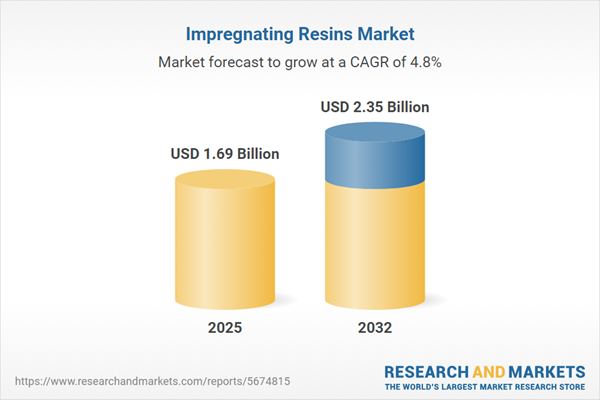Speak directly to the analyst to clarify any post sales queries you may have.
The impregnating resins market is pivotal in strengthening industrial components and protecting critical equipment. With continuous innovation and rising performance requirements, these specialized materials are foundational to reliability and operational efficiency across diverse sectors.
Market Snapshot: Impregnating Resins Market Growth and Opportunity
The impregnating resins market grew from USD 1.61 billion in 2024 to USD 1.69 billion in 2025. It is expected to continue growing at a CAGR of 4.84%, projected to reach USD 2.35 billion by 2032. This sustained expansion is underpinned by widespread adoption in manufacturing, infrastructure, and electronics, along with the increasing focus on high-performance protective solutions and sustainability initiatives.
Scope & Segmentation of the Global Impregnating Resins Market
This comprehensive report examines the breadth of the impregnating resins market across several crucial dimensions, enabling targeted analysis for strategic decision-making:
- Type: Acrylic resin, epoxy resin, polyester resin, polyurethane resin, silicone resin
- Application: Adhesive, coating (anti-corrosion, moisture barrier, protective), electrical insulation (generator, motor, stator, transformer), encapsulation
- End-Use Industry: Aerospace & defense (civil aviation, military aircraft, spacecraft, weapons systems), automotive (commercial vehicles, electric vehicles, passenger vehicles, two-wheelers), electronics & electrical (consumer electronics, medical devices, power electronics, telecommunications equipment), energy & power (oil & gas, power generation, renewable energy, transmission & distribution), industrial machinery (construction, packaging, printing, textile machinery)
- Form: Liquid (single component, two component), powder
- Function: Flame retardant (halogen-free, halogenated), non-flame retardant
- Geography: Americas (North America: United States, Canada, Mexico; Latin America: Brazil, Argentina, Chile, Colombia, Peru), Europe, Middle East & Africa (Europe: United Kingdom, Germany, France, Russia, Italy, Spain, Netherlands, Sweden, Poland, Switzerland; Middle East: United Arab Emirates, Saudi Arabia, Qatar, Turkey, Israel; Africa: South Africa, Nigeria, Egypt, Kenya), Asia-Pacific (China, India, Japan, Australia, South Korea, Indonesia, Thailand, Malaysia, Singapore, Taiwan)
- Leading Companies: Hexion Inc., Allnex Belgium SA, Huntsman International LLC, Olin Corporation, Sumitomo Bakelite Co., Ltd., DIC Corporation, Lonza Group AG, Polynt-Reichhold Group S.p.A., Kukdo Chemical Co., Ltd., Kolon Industries, Inc.
Key Takeaways for Senior Decision-Makers
- Impregnating resins deliver advanced protection by enhancing mechanical and electrical properties in mission-critical applications, fostering lower lifecycle costs and improved system reliability.
- Sustainability mandates and regulatory compliance are propelling a shift towards water-based, bio-derived, and halogen-free resin formulations, without sacrificing critical performance metrics.
- Integration of digital technologies such as process automation, digital twins, and data analytics is optimizing curing processes, minimizing defects, and reducing production cycle times.
- Collaboration across chemical manufacturers, OEMs, and supply chain partners is enabling agile responses to volatile market conditions and supporting differentiated value propositions.
- Regional dynamics, including the rapid electrification in Asia-Pacific and environmental regulations in the Americas and Europe, require strategic alignment of product portfolios and supply infrastructures.
- Industry 4.0, additive manufacturing, and next-generation composite technologies are expanding new use cases and facilitating the customization of resin systems to address evolving end-user demands.
Tariff Impact and Strategic Procurement Adjustments
The introduction of United States tariffs in 2025 is creating challenges for raw material sourcing and cost structures among resin manufacturers. New duties on key inputs have led to increased pricing, prompting strategic moves such as alternative supply partnerships, dual sourcing, and localized production. downstream buyers are also adjusting contract terms and pursuing value engineering to manage cost pass-through and ensure supply chain resilience.
Methodology & Data Sources
This report combines insights from direct interviews with industry leaders, material scientists, and procurement specialists, along with secondary research drawn from technical publications, regulatory documents, and industry databases. Findings are validated through quantitative analysis and scenario modeling to ensure robust, actionable intelligence.
Why This Report Matters
- Enables strategic planning by providing clear segmentation and regional insights for targeting growth opportunities and mitigating risks in the impregnating resins market.
- Supports procurement and innovation strategies with up-to-date intelligence on sustainability drivers, tariff impacts, and digital transformation trends.
- Empowers leadership teams to benchmark against leading companies and adjust to evolving regulatory, technological, and supply chain landscapes.
Conclusion
The impregnating resins market continues to evolve through advances in material science and manufacturing technology. Decision-makers equipped with actionable insights and a nuanced understanding of regional trends will be well-positioned to navigate uncertainties and capitalize on emerging opportunities.
Additional Product Information:
- Purchase of this report includes 1 year online access with quarterly updates.
- This report can be updated on request. Please contact our Customer Experience team using the Ask a Question widget on our website.
Table of Contents
3. Executive Summary
4. Market Overview
7. Cumulative Impact of Artificial Intelligence 2025
Companies Mentioned
The companies profiled in this Impregnating Resins market report include:- Hexion Inc.
- Allnex Belgium SA
- Huntsman International LLC
- Olin Corporation
- Sumitomo Bakelite Co., Ltd.
- DIC Corporation
- Lonza Group AG
- Polynt-Reichhold Group S.p.A.
- Kukdo Chemical Co., Ltd.
- Kolon Industries, Inc.
Table Information
| Report Attribute | Details |
|---|---|
| No. of Pages | 187 |
| Published | October 2025 |
| Forecast Period | 2025 - 2032 |
| Estimated Market Value ( USD | $ 1.69 Billion |
| Forecasted Market Value ( USD | $ 2.35 Billion |
| Compound Annual Growth Rate | 4.8% |
| Regions Covered | Global |
| No. of Companies Mentioned | 11 |









